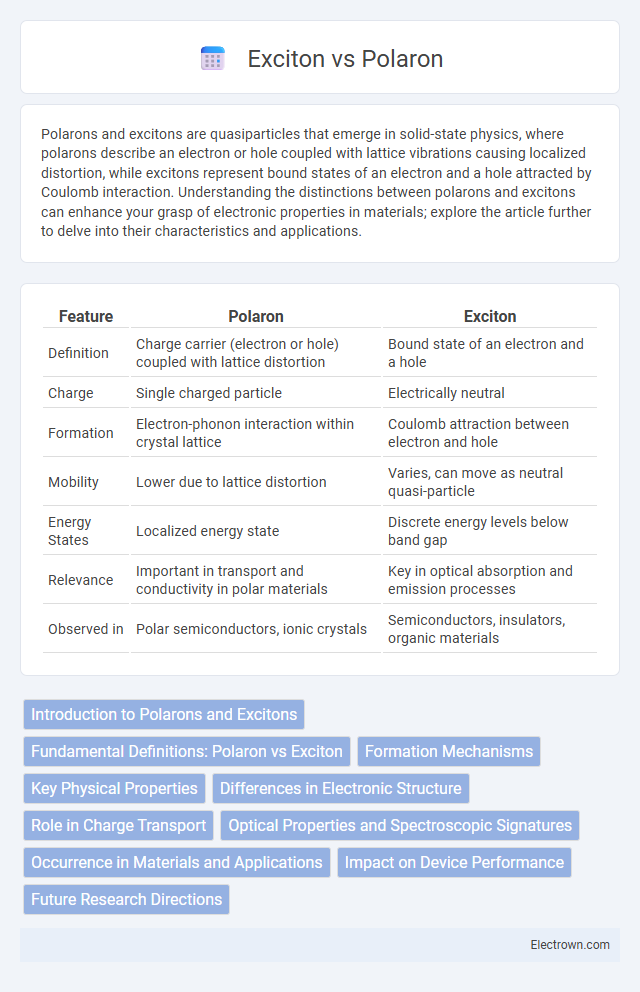Polarons and excitons are quasiparticles that emerge in solid-state physics, where polarons describe an electron or hole coupled with lattice vibrations causing localized distortion, while excitons represent bound states of an electron and a hole attracted by Coulomb interaction. Understanding the distinctions between polarons and excitons can enhance your grasp of electronic properties in materials; explore the article further to delve into their characteristics and applications.
Table of Comparison
| Feature | Polaron | Exciton |
|---|---|---|
| Definition | Charge carrier (electron or hole) coupled with lattice distortion | Bound state of an electron and a hole |
| Charge | Single charged particle | Electrically neutral |
| Formation | Electron-phonon interaction within crystal lattice | Coulomb attraction between electron and hole |
| Mobility | Lower due to lattice distortion | Varies, can move as neutral quasi-particle |
| Energy States | Localized energy state | Discrete energy levels below band gap |
| Relevance | Important in transport and conductivity in polar materials | Key in optical absorption and emission processes |
| Observed in | Polar semiconductors, ionic crystals | Semiconductors, insulators, organic materials |
Introduction to Polarons and Excitons
Polarons are quasiparticles formed when electrons or holes interact with lattice vibrations in a crystal, leading to localized charge carriers coupled with phonons. Excitons are bound states of an electron and a hole attracted by Coulomb forces within a semiconductor or insulator, playing a crucial role in optical properties and energy transport. Understanding these quasiparticles helps you optimize materials for electronic and optoelectronic applications by tailoring charge carrier dynamics and interactions.
Fundamental Definitions: Polaron vs Exciton
A polaron is a quasiparticle formed when an electron or hole interacts with lattice vibrations in a crystal, causing local distortion and modifying its effective mass. An exciton consists of a bound state between an electron and a hole attracted to each other by Coulomb forces within a semiconductor or insulator. Understanding these fundamental differences helps you analyze charge transport and optical properties in materials.
Formation Mechanisms
Polarons form when charge carriers, such as electrons or holes, interact strongly with lattice vibrations, leading to a localized distortion of the crystal lattice and the stabilization of the combined quasiparticle. Excitons arise from the Coulomb attraction between an electron and a hole bound together in a semiconductor or insulator, creating a neutral quasiparticle without lattice distortion. The key difference in formation mechanisms is that polarons involve electron-phonon coupling causing lattice deformation, whereas excitons result from electron-hole pair binding driven by electrostatic forces.
Key Physical Properties
Polarons are quasi-particles formed by electrons coupled with lattice vibrations, characterized by effective mass increase and localized charge carriers, whereas excitons are bound states of electron-hole pairs exhibiting distinct binding energy and Bohr radius. Polaron mobility depends heavily on electron-phonon interaction strength, often resulting in lower mobility compared to excitons, which show optical activity and can transport energy without net charge. Excitons typically manifest in semiconductors and insulators with specific recombination lifetimes, while polarons influence electrical conductivity and play a critical role in organic and inorganic materials under varying temperature conditions.
Differences in Electronic Structure
Polarons differ from excitons primarily in their electronic structure; a polaron consists of an electron or hole coupled with lattice deformation in a crystal, causing localized charge and altered energy states. Excitons are bound states of an electron and a hole attracted by Coulomb interaction, without significant lattice distortion. This fundamental contrast affects charge transport and recombination processes in materials such as semiconductors and organic crystals.
Role in Charge Transport
Polarons facilitate charge transport in organic and inorganic semiconductors by coupling charge carriers with lattice distortions, enabling mobility through localized states. Excitons, on the other hand, represent bound electron-hole pairs that can migrate energy without net charge transfer, primarily influencing optical properties rather than direct charge conduction. Understanding polaron dynamics is crucial for improving conductivity in materials like conjugated polymers, while exciton behavior underpins the efficiency of devices such as organic photovoltaics and light-emitting diodes.
Optical Properties and Spectroscopic Signatures
Polarons exhibit mid-infrared absorption features due to localized charge carriers interacting with lattice vibrations, while excitons show sharp optical absorption peaks near the semiconductor band edge representing bound electron-hole pairs. Spectroscopic signatures of polarons often include broad, asymmetric lines in photoluminescence and infrared spectra, whereas excitons present narrow, well-defined emission lines with strong exciton binding energy evident in absorption and photoluminescence excitation spectra. Distinguishing between polaron and exciton optical responses is crucial for interpreting charge dynamics in materials like organic semiconductors and transition metal oxides.
Occurrence in Materials and Applications
Polarons commonly occur in ionic crystals and organic semiconductors, where electron-phonon interactions cause charge carriers to distort the lattice, impacting conductivity and optoelectronic properties. Excitons form in semiconductors and insulators through electron-hole pair binding, playing a critical role in light emission and photovoltaic devices. Your understanding of these quasiparticles enhances the design of materials for applications like solar cells, LEDs, and sensors.
Impact on Device Performance
Polarons and excitons significantly affect the performance of optoelectronic devices such as organic solar cells and light-emitting diodes. Polarons, which are charge carriers coupled with lattice distortions, influence charge mobility and recombination rates, directly impacting device efficiency and stability. Excitons, bound electron-hole pairs, determine the efficiency of charge separation and light emission processes, making their management crucial for optimizing photophysical properties and overall device performance.
Future Research Directions
Future research on polarons and excitons will emphasize the development of advanced materials with tailored charge transport and optical properties, crucial for next-generation optoelectronic devices. Investigations into strong coupling regimes and hybrid quasiparticles aim to enhance quantum efficiency in photovoltaics and light-emitting diodes. Computational modeling combined with ultrafast spectroscopy techniques will drive the understanding of dynamic interactions and coherence in low-dimensional systems.
polaron vs exciton Infographic

 electrown.com
electrown.com